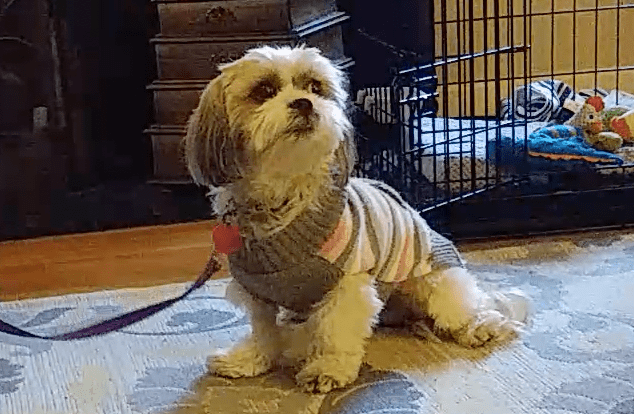The following is a live audio transcription from my first hour of meeting and training this dog named Tila. She is going to learn how positive reinforcement helps her to listen, while her owner learns how to get and keep her dog’s attention. She will also learn that growling at people (me included) and at the owners young nieces and nephews will not be tolerated any longer, and that pulling on the leash will also come to an end.
These Are the Day’s Goals
I start the day discovering that Tila wants to bite me because I have separated her from her owner. Dogs who are so needy and so insecure, will bite anyone who tries to stop them from reaching their goal, (her owner). Tila’s goal is to go and glomm back onto her mother in order to gain back her power and leadership role over her…knowing she can’t get it from me.
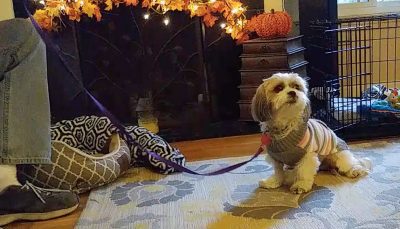
This Text Puts the Spotlight on My Positive Reinforcement Approach
I always begin my trainings with Stop Sit and Wait. This begins when I put the leash on Tila and move her away from her owner…I’m Speaker 2.
Speaker 1: It makes it for a hard walk ’cause every time we start walking, any time there’s a dog, she’ll go after them. She will start … I’m like, “Are you being aggressive?” I can’t tell if she wants to be aggressive or if she wants to play.
Speaker 2: Do you ever let her sniff the other dog and go to that point to where you test her?
Speaker 1: There’s been a couple times where she’s done that, and it’s hit and miss.
Speaker 2: So sometimes she growls and sometimes she just sniffs.
Speaker 1: Right, right, right.
Speaker 2: Okay, so are you thinking about what you’re thinking about when you are in that situation?
Speaker 1: Yeah, I get nervous. I start to get nervous, and I start to think like, “Shoot. If she starts to growl, or what happens if …” and I know I tense up. I know I get like, “I’m not sure what to do in that situation.” There have been times … because I took her with me to Hoboken in New Jersey, and everyone has a dog. So I’m like, we have to do this, because-
Speaker 2: Right. She has to be around other dogs.
Speaker 1: She has to be around other dogs.
Speaker 2: She has to at least acknowledge them and maybe sniff ’em, but not, “Oh, my God. Another dog.”
Speaker 1: Right. So that’s hard. I want her to be able to walk and not pay much attention to the other dogs.
Speaker 2: Let me see. Let me see, girl. What’s her name again?
Speaker 1: Tila.
Speaker 2: Sheila?
Speaker 1: Tila.
Speaker 2: Oh, Tila. That’s right. Tila Tequila. Now it’s coming back.
Speaker 1: Yes.
Speaker 2: All right. So Tila Tequila. I wanna do a little test with Tila, and I wanna see how Tila is.
Speaker 1: Come on.
Speaker 2: See? She’s already pretty glomming. It’s all about you and just get away from this guy as far and as fast I can.
Speaker 1: Right.
Speaker 2: That’s nice and tight. Good. That’s what I want to make sure. Have a seat. Just sit back. No. You just sit here.
Speaker 1: Oh, okay.
Speaker 2: Actually, let’s trade. You sit over here, ’cause I need you away from your doggie a little bit.
Speaker 1: Right.
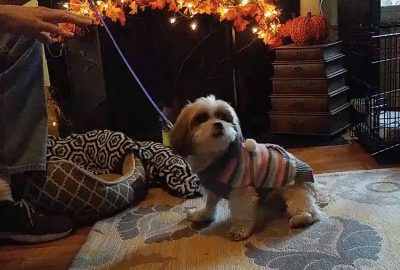
Speaker 2: I need to see how dog is. Come on. Tila. Oh, no. The first thing I like to do is kinda get her to calm down a little bit.
Speaker 1: [inaudible 00:02:34] I’m sorry. Right? Just to relax?
Speaker 2: Yeah. I want to see if I can get her in a little different state of mind because she looks like she’s slightly panicking there a little bit without being-
Speaker 1: She’s getting a little nervous.
Speaker 2: Yeah. She’s a Velcro …
Hold on.
She’s very nervous.
Hold on. Relax. Shh. Hold on. Shh. Sit. Sit. Her eyes are just saucers. They’re so big. I just need her to chill out a little.
Sit down.
Does she know, do you know, does she know commands at all?
Speaker 1: Yeah, she knows sit. She has a hard time with stay. But she knows sit.
Speaker 2: The stay is the interesting part.
Speaker 1: That’s a hard one that is-
Speaker 2: That’s what we’re gonna work on because …
Hold on.
Speaker 1: She’ll do it for a little while. I’m like, “All right. Stay. Stay right there.” I have to tell her, like, “I’ll be back. You stay.” She’ll stay for a while, but her attention is this.
Speaker 2: It is. It’s zero right now. I’m already seeing.
Sit down. Good. Just stop. Stop.
So what I want to do is I want to see if I can teach her anything, a basic, basic command. I have that same treat, the green one.
Speaker 1: Oh, down there?
Speaker 2: I think so. It’s pretty … the new one. All right. So hold on. So what I gotta do is just get Tila to think about and not be so, “Where’s Mom? Where’s Mom? Oh, she’s four inches farther than I need her. I gotta deal with that.” So I want her to kinda calm down and just relax a little bit so we can get her in more of a normal state instead of this …
Speaker 1: Anxiety, anxious …
Speaker 2: Right. Your gardeners do not help. Every dog in America has some sort of … I mean, they may be a minimal reaction, or they may be trying to go to every window to kill them as they travel through the backyard. They go … and the blinds are nice and torn, the wood ones, or the plastic ones, or whatever they are, just thrashed in some certain homes because the dog follows the gardener.
Speaker 1: Wanted to go, right.
Speaker 2: So there you go. Hey. That’s very good, Tila. Thank you. That’s a little better. Hold on. No. Sit. Sit. Sit. Sit. Sit. Sit down. Sit. No. Sit. Stop. Stop. Good. There you go. Stop. Stop. Good. So through positive reinforcement, I’m gonna keep reminding her that she’s doing stuff that I want. That’s what positive …Hey, hold on. Hey. Stop.
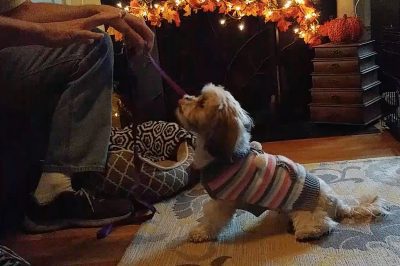
That’s what positive reinforcement’s all about. I’m gonna move this back here a little bit.
Hold on. Shh. Do you have any more light, or is this basically it? It’s okay if it is. There’s a little. I’ll take it.
Speaker 1: That a little better?
Speaker 2: Yeah. Good. Anything.
Hey, hey, hey. Sit down. Sit. Sit. Tila. Sit. Sit. Good. There ya go. She’s not used to listening, really, to anybody maybe but you, and maybe she doesn’t really even listen to you. She kind of understands generally what maybe you want. When you call her, does she come right to you?
Speaker 1: Normally, yeah.
Speaker 2: She does?
Speaker 1: Yeah, she’ll come.
Speaker 2: That’s good.
Speaker 1: Normally. Sometimes she doesn’t.
Speaker 2: Stop.
Speaker 1: But normally, she will.
Speaker 2: Let’s just see how she’s doing here. She’s getting a little better now.
There you go. There you go. So what I’m gonna do is my positive reinforcement program called stop, sit, and wait. Hold on. Good. Hold on. Hey.
What that does is help speed along the learning process because the main issue is that people have dogs that don’t really understand you. They live in their world in your world instead of being incorporated in your world. They have their world, and then you have your world. So what I try to do is bring them into your world and be aware of your world more and of you more and of a deeper connection and understanding.
So when you look at a dog, and you … like you have a son, and your son’s going, “Mom, Mom, Mom,” and you’re on the phone. “Mom, Mom, I need to talk to you,” and you’re on the phone. So what do you do? You go, “Hold on a second.” You put the phone down. “Excuse me a second. I’m talking, and I’ll get to you in a moment. But I don’t want you to sit here and go, ‘Mom, Mom, Mom, Mom, Mom, Mom,’ over and over until I finally give up and go, ‘All right. What do you want?'”
So we don’t want to get there. So we want to calmly, as the leader … a leader is calm and assertive. Assertive is I’m gonna make sure that I do what I want, but …Up. Up. Up. Up. Up. Up. Good. Stop. I want to make sure that I do what I …Hey, hey, hey. Hold on. There ya go. I’m being calm and
Up. No. Up. Up. Up. Stop. When a dog lays down, they tune out. Tila will, “Wake me when this is over.” So that’s what I’m doing. I’m trying to keep her …
Speaker 1: Listening.
Speaker 2: Hey. Good. Right here.
I want her to concentrate on me. She’s looking at you like-
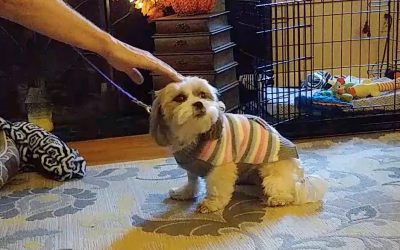
Speaker 1: Help me.
Speaker 2: “Mom, this guy. Help me, Mom. Mom.” Right? I know that. I understand that. But we’ve got to keep her calm whether she’s in your face or over there. When dogs get so needy, they’re like, “I can’t think of anything other than I gotta get off of this cliff. I’m sitting on the edge of this cliff, and I need to get away from it.”
That’s kinda how they are with their owners, some dogs, because they’re always just so pensive that, “Hurry up, hurry up, hurry up, and save me,” kind of a mentality. We want ’em to be a little more self-reliant and not so needy.
Speaker 1: Confident. I think, too, because I just got back, I hadn’t been away from her for this long. So I just got back, and I feel like a lot of things just started to revert. I’m like, “Oh, here we go.” Like she won’t eat unless I’m standing next to her again, like right now. I’m like, “Ugh.” So that all kind of stopped, and then I was gone-
Speaker 2: You mean when you were gone for the eight days or whatever?
Speaker 1: Yeah, and when I came back, now she’s like, “Where are you?” Every time I put her food, and now she’s like, she won’t eat unless I’m standing there.
Speaker 2: Okay, ’cause you left for eight days.
Speaker 1: Right.
Speaker 2: She thought she did something wrong or whatever.
Speaker 1: Right, right, right. So right now, she’s being very shadow.
Speaker 2: Too glomming.
Speaker 1: Yeah.
Speaker 2: Very needy. So we don’t want that. We want to discourage that. We want her to go back to feeling a little more comfortable on her own and her own … Now, what I’m doing is I’m finding ways to bring her attention back to me. You can look at her. You think she’s paying attention to me, but she’s like this.
Speaker 1: Right.
Speaker 2: Willing you to look at her.
Speaker 1: Her eyes. Her eyes.
Speaker 2: Willing you to … “Hey, look at me. Help me.” There. Stop. So she finally … my energy, if you noticed, when I started emulating her, like, “I’m really needy. I need to be near Mom,” then she senses that, ’cause dogs are very keen on our energy. That’s why I was asking you, first off, what was your energy like when you see your dog pulling towards another dog.
You’re imagining, well, it could be one or the other. It could be she wants to go bite that dog, and then that other dog is gonna chew my dog up because it’s three times the size or whatever. Or the dog is just gonna go up there and sniff, and things are gonna be fine, or somewhere in the middle. Some dogs may go, “Hey, you’re too close to me. You’re too personal. Back off,” and that’s what dogs do.
If this little dog goes, “Hey, hey, hey, no. I’ve never seen you before. I’m your neighbor. What’s goin’ on?” Then the dog may go, “Well, I’m just hanging out here. I’ve been here for nine years. It’s my place right down the road.” Or it’s like, “Dude, get out of my face. You’re pushing me, and I don’t like that, and if you keep doing it, then I will …”
Speaker 1: Nip you.
Speaker 2: “… up my intensity to remind you that I don’t want you to do what it is that you’re doing.” So dogs regulate other dogs. If a dog is playing too much with another dog, then that dog will go, “Hey, hey, hey.” So it’s helping them to regulate …
Good. Good girl. There you go.
Now, did you see that she was getting ready to lay down?
Speaker 1: Mm-hmm (affirmative).
Speaker 2: It looked like she was like, “Well, I’m gonna find a nice little place and just go to sleep until this guy leaves.”
Good. But this is how the stop sit & wait, this is how you start regrouping your dog’s focus, because dogs, they’re like a cut electric wire. It’s shooting out information, but nothing’s going in. It’s all, “Oh, I’m nervous. I’m this. I’m feeling this, and this is how I’m explaining it to all of you out there. I’m signaling I’m very nervous, or I’m really …”
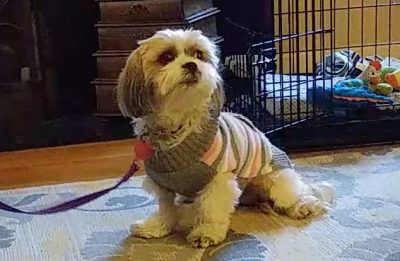
What we want them to do is kinda change. We want to encourage a calmer, more thoughtful … like if you were drowning, and someone’s trying to have a normal conversation with you, you can’t go there. You’re panicking. So when someone says, “Hey, listen. I see that bla bla bla,” you’re like, “Help. Help.” So in a sense, dogs kind of panic. Some dogs, not all dogs, but …Good.
Some dogs, they get into these panics, and then they’re so nervous, they’re like a kid in a horror movie inside the house. “I don’t know. This house is kind of creepy,” and then eventually, something creepy happens, or they make it up because they’re ready for any little creak, “Oh, that was a ghost, that sound in the house.” Whatever. They start manufacturing their own fears and their own situations, and they amp themselves up.
We want to go into a scary place, like Halloween. We want to get scared. As kids, “Oh, scare us in the haunted house.” So it’s more of a way to keep your doggie …There you go.
Keep your doggie calmer. You’ve gotta be thinking about what you’re thinking about, too, ’cause if you’re like, “Oh, don’t bite that dog, or don’t you do that. Watch out. I gotta be really cautious of you because you’re gonna … I don’t want you to worry about that … get sued by that owner if you bite him,” or whatever.
So we need you to be the leader, the calm. See, I’m calm, but I’m also assertive. I’m not letting the dog lay down or go to you, or all those things that I’m sensing that it probably would rather do than just sit here and listen to me. It’s facing you. So it’s already telling me, “There’s my goal.” Then I’ll turn the dog this way, and it’ll eventually move …
Right here. Come here. Come here. Good. Stop Sit & Wait
Speaker 1: Will this also work, because she has a problem with-
Speaker 2: No. Sit down.
Speaker 1: … with kids.
Speaker 2: There you go. Say that again?
Speaker 1: She has a problem with kids.
Speaker 2: Sit.
Speaker 1: She does not-
Speaker 2: No. Sit. Good. Go ahead. I’m still listening.
Speaker 1: She doesn’t like them.
Speaker 2: Stop.
Speaker 1: She does not like them. She doesn’t want to be near them. She doesn’t want them to touch her. She has-
Speaker 2: Energy.
Speaker 1: … snipped at some kids, and I’m like, “Oh, my gosh.”
Speaker 2: Little kids have different energy. They have more flying off, like the cut electrical wire, kids do. So maybe doggie is turned off by that or is drawn to it for whatever reason. So there’s that energy … now, remember when I was telling you? I moved her this way so that I could show you what she really wants is you, and it’s not just she’s …Good. Thank you.
I want her to resolve that she’s just gonna hang out here with me but not be frightened, not be worried, not like, “Oh, my God. What’s gonna happen to me next?” Sit up. Stop. Stop. Good. Stop. I’m purposely facing her away from you so that I can see her turn and I can see how nervous …
Speaker 1: Right. Right. Right.
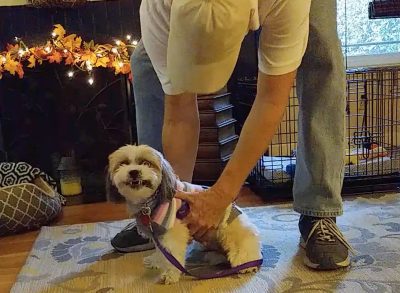
Speaker 2: Hey. Hey. Tila. Tila. Stop. It’s okay, honey. There you go. You just relax. There you go. Oh, are you growling? Are you growling at me? No. Don’t growl. No. Stop. Don’t growl. I’m gonna see a little bit of this. Stop. No growl. Stop. Stop. Stop. Stop. So there’s the ticket.
Speaker 1: Right.
Speaker 2: There’s the, “I’m about done with you, and I’m about to …” Stop. Stop. Stop.
So we gotta nix that. We can’t let that rise. It’s like a little kid getting madder and madder at his teacher, and the teacher finally goes, “You know what?” To herself, “I sense that this kid is gonna want to smack me or do something, so I’m gonna send him to the principal and just get him out of the room.”
The problem with that is that when people take dogs out of situations that they don’t want, that they’re afraid, like you see another dog being walked, instead of putting the dog through that situation, you go around. You avoid. So the dog never has a resolution about that certain dog or about greeting regular dogs, regular people that are walking.
Not everybody is so nervous. They’re more comfortable. They’re more calm, assertive. You see them, comfortable, walking, not dragging, just having a nice conversation, walking my dog. Then dog sees a squirrel, “No. No. We don’t want that. No, you can’t chase that squirrel,” and then we just keep going. We see another dog. Hey. Hey. Come here. Good. Sit. Good. There you go. Hey. Hey. Don’t you get a little snippy with me. No.
You’re gonna be okay. No. I don’t want you biting me. I don’t want you biting me. I don’t like it when I’m bit. No. I don’t like it. Stop.
See if we can do a little stop, sit, and wait. This is how I really test, once we get a dog in a calmer, supposedly, calmer state, then I start testing. I start increasing the energy and seeing where the dog snaps, find out where … that was just it. That’s where it bites me.
That’s where it just can’t stand it anymore, and it just has to act out in whatever way that it feels it’s ready to act out, like, “Dude, if you push me again, I will …” Then I push. “Well, I’ll do it again, I will.” Then I push. Then eventually, the dog goes, “Okay. No, I’m not gonna bite that. You win. I will be submissive. I will be a good listener.”
Don’t you bite me. No. Don’t you bite me. Stop. Let me see. All right. Hold on. Hold on. Let me see. No biting. So I’m gonna do a little testing here.
Hold on. Hold on. Hold on. Let me make sure I can get some of this. Let me see. Let me see. Shh. So this is just another way that I …Hold on. There we go. Relax. There we go.
I’m just gonna kinda desensitize a little bit now. Earlier, dog wouldn’t let me pick her up, and I sensed that, “Well, that’s a one picked up kind of dog.” So what I do is I push the envelope. I have them do the things that they don’t normally do, and right now, what I’m doing …
Hey. Hold on. Sit. I’m lifting just slightly off the ground.
Hold on. Hey, hey, hey, hey. No. Stop. No. No. You just relax. No growling. No growling. Good. Just relax. Hey, hey, hey, hey. No. Stop. There you go. There you go. She could be all talk and no action. But we’ll see. We’ll see. I just wanna kinda test …Hey. Hold on. Shh. No. No. Stop. Hold on. Shh. Stop, stop, stop, stop. Stop. Stop.
Speaker 3: [inaudible 00:22:33] cut the grass first [crosstalk 00:22:35] outside [crosstalk 00:22:35]
Speaker 1: Are we gonna go outside? Is everything gonna be inside or outside?
Speaker 2: Mostly. We can go outside, though, too.
Speaker 1: If you want to cut it, that’s fine.
Speaker 3: I was thinking of cutting that first.
Speaker 1: Okay.
Speaker 3: You can go outside.
Speaker 1: All right. Thanks.
Speaker 2: Good.
Speaker 1: [crosstalk 00:22:51] crazy right now. No. Right? I know. I know.
Speaker 2: There you go. Good. Thank you. There you go. There you go. Shh. Relax. Relax.
Speaker 1: Usually, they come on Friday, so I was like, “No. Why are they here?” That’s okay.
Speaker 2: There you go. I’m just continuing to knock down some of that “eff you,” I guess it is. Whenever she’s going, “You just touched me,” that snappy little attitude, I’m gonna go through. I wanna kinda push it out of her in a sense. I wanna have her just get through it and know that I’m not hurting her, I’m just kind of inconveniencing her for the moment to test her ability to either accept it or to fight like hell and say, “I’m not gonna let you touch me, and that’s how extreme I really am.”
But right now, she put up a little bit of fuss, but not too much. Right? It wasn’t so bad. No. No. No. No. Let me see. Let me see. There you go. Sit down. Sit. Sit. There. Good. So I just gotta take over her in a sense. Let me see. There. There you go. Good. Shh.
And kinda push her out of her … Like when a kid goes to camp, he doesn’t like it. He hates it.
He’s being away from home, bla bla bla, until he meets one person that feels the same way, and he can kinda maybe connect to him with or whatever. Then the whole experience of camp changes. Now he’s like, “I don’t wanna go home.” So in a sense, that’s kinda what I’m trying to do. I’m trying to find a little breakthrough.
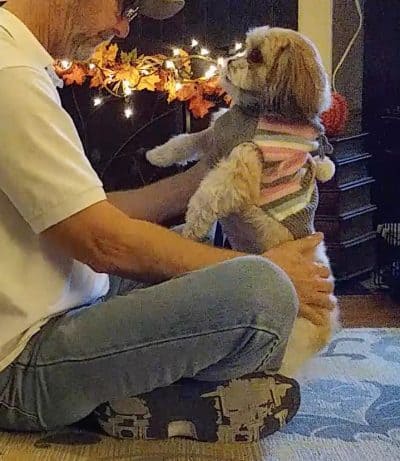
There. So there was no growl at that time. Then so I’m kinda retesting to make sure the doggie can allow me to pick it up and kinda mess with it but have it not, “Hey, don’t you touch me. Leave me alone. I don’t need this crap.” However they put up with this, it tells me if they’re okay with it. If they’re like, “Sure, go ahead. This is cool. I kinda like a massage. I feel like I’m a little tense. I need to calm down a little bit,” or it’s the opposite. It’s like, “If you keep touching me, I’m gonna bite you when I get that first chance when that thumb comes round.”
Hey. Hello. Hello. No. All right. Come here. Sit. Sit. Hey, sit. Sit. Sit. Sit. Sit down. She knows sit. I know that she knows sit down. Hey. Hey. Tila, sit. There you go. There you go. Hold on. Don’t bite me. Don’t bite me. There you go. Good. Just stop. Just stop. Good. Thank you.
I just want her to relent there a little bit, just sit there and not react to anything, just kinda take it. Good. So when I see that she’s not moving, she’s not …
Speaker 1: Searching me out or trying to …
Speaker 2: Right? Following you everywhere I go. “Oh, where are you going now? You sneaking up on me?” She’s not quite doing that. But some dogs do, depending on how … They’re like fists. They’re freaking out. So what does that do? This is a way to evaluate, right?
Hey. How are you doing? How are you doing? Good, Tila. That’s very good.
No. No. No. There you go. No. Don’t growl. Don’t growl.
So she’s on alert. She’s watching you petting me. Now I’m gonna kind of over-pet her, but I got this just in case she’s gonna bite me.
Hold on. Hold on. Shh. Relax. Hold on. Shh. Let me see. Just get it out. Stop. Just get it out. Go on. There ya go. You get that out. You get that out. You get it out. There. There ya go. That’s not bad. Sit. Sit. Hey. Perfect. That was good. That was really good. You see?
So what I want to show her …No. No growling. Hey.
What I want to show her is compassion but leadership. I’m not gonna let her get away with this little … these little pot shots that she’s taking at me as if you … If you’re correcting your son, and he’s, “Yeah, yeah, whatever, Mom. I’ll sit here but I won’t like it,” these little exclamations of standing my ground a little bit until I relent to the leader, is kinda normal. Right?
Someone gets taken over, they don’t like the new boss, the new administrator of their town, or the new leader of their party, or whatever, there’s some things that we don’t really …There you go. Come here. Come here. There you go. Come on. Come on. Right up here. Come on. No. Don’t make those … Hey. Hey. Hey. Hey. Hey. Hey. No. Look at that.
Speaker 1: I know.

Speaker 2: She can look really vicious.
Speaker 1: She does.
Speaker 2: You look so vicious.
Speaker 1: I think that’s what she gets like with kids for sure and some strangers. That worries me.
Speaker 2: Look at those eyes.
Speaker 1: I know.
Speaker 2: “I’m gonna get you.” [crosstalk 00:29:56] fingers near my face.
Speaker 1: Either she loves you with those eyes or she hates you with those eyes.
Speaker 2: Yes. They’re very expressive. Yes.
Let me see you. Let me see you. Mm-hmm (affirmative).
So that’s just desensitizing. I’m over-jostling her so that I can test to see how far she’s gonna take it until she goes, “I’ll kill you. I’m gonna get ya.”
Speaker 1: I was calling her Puss in Boots. I’m like, she’s so cute. She looks so cute, but then-
Speaker 2: She is.
Speaker 1: Then she has that, “I will kill you.”
Speaker 2: That’s that issue, where she goes, is what’s gonna get her into trouble. That’s her core value that makes her want to hold onto whatever she’s holding onto. There you go. Look at that. Let me see. Let me see.
Speaker 1: I think when my niece had her too, they had kids, and my nephew’s kids were tormenting her. So I think there’s so much of that.
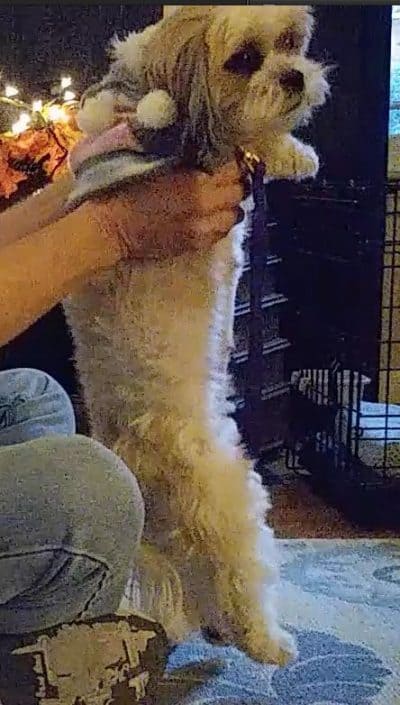
Speaker 2: Let me see. Let me see you. Give her a little massage. Here you go. There you go. Let me see that. Let me see that. Shh. There you go. There you go. It just takes some of that tension right out of her. Now, by picking her up like this, what I’m trying to do is get her to stretch. When you lift them just the toes just off the ground, she’s starting to reach from the ground. So in a way, that’s helping her stretch. It’s helping her relax because I want her to reach towards that floor.
There you go. There you go. There you go. Hold on. Come here. Sit. Sit. Sit. Sit. Come here. Sit down. Good. There you go. Here you go. Perfect. Thank you. Just stop. Stop. I’m not sure if I got that or not. I think I might’ve. Yeah. I missed it.
How you doin’? Good. Good girl, Tila. Good girl. Good girl. There you go. Thank you. So I think I’ve knocked it down a little. Maybe if it was at an eight, it could be about a six or five and a half, or whatever. Not growling anymore. So I can come over and give her little jolts and jostles.
Here you go. Good. Up. Sit up. Up. Sit up. There you go. Good. Hey. Did you throw your teeth at me? Did you? Come here. Come on.
How is she on walks?
Speaker 1: She’s really good on walks.
Speaker 2: Come on. Come on.
Speaker 1: She’s really good on walks as far as … sometimes she’ll want to be the leader, and sometimes she’ll want to just sit right by me.
Speaker 2: Let’s walk. Come on. Let’s just do our little walk.
Speaker 1: But if it’s two people, if I’m walking with her, and my friend’s with me or my husband’s with me, she can’t do that. When my husband has her, she’ll keep looking for me.
Speaker 2: What does she want to do?
Speaker 1: When we’re walking, she can’t figure out where she’s supposed to be.
Speaker 2: Which allegiance-
Speaker 1: Yeah.
Speaker 2: To you or your husband.
Speaker 1: Right. Or she’ll walk with my husband, but she’ll keep stopping and looking for me. When I’m with my friend-
Speaker 2: That’s what we’re seeing here. Right?
Speaker 1: Yeah.
Speaker 2: We’re seeing that it’s like a Velcro dog. I need to be stuck to you. So what we want to do is we want to take a little of that baby-ness …
Hey. Come here. Come on. There you go. Stop. Hey. Come here. Sit. Come here. Sit. Sit down. Good. Stop. Stop. Good.
We’re just gonna see if we’re gonna be past the growling stage.
Speaker 1: Okay.
Speaker 2: Hold on. Sit. No. Come here. Sit. Okay. Right there. Come here. Come here. Sit. Stop. Good. There you go. No growling. Not even a lip. I don’t even want a lip. I don’t want no lip from you. Yeah. No lip at all. Good. Good. So now, we’ll go back to …Hey. Hey. Hey. Tila. Tila. Stop. Stop.
Do you see that she hadn’t looked at me? I stood up, and she was looking down and around over here, but I wanted her to acknowledge me, look right at me. Then, when she did, I go, “Good. Just stop.” But if you’re trying to get somebody to listen to you, and you’re talking to me, and I’m doing this, do you think I’m listening to you? But the moment I lock on, that’s when you see me look at you. Then you go … whatever the command was, now that you see that I’m boom, like your kid, “Yeah, yeah, Mom. I’m listening.”
So I’m playing my little game, and then you go, “Drop the game, and look at me.” “What?” “I need you to clean your room, now that I have your focus. Game is down. I need you to clean your room and do the things that I said, take out the garbage. Then you can play your video game.” That’s the rule now. That’s the assertive command that I’ve given you, and I’d like you to fulfill it. That’s like the underlying agreement between mothers and sons and families and stuff, but that they agree to agree, or whatever.
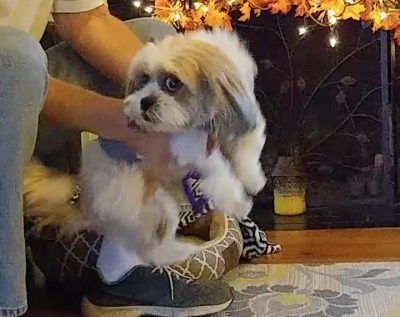
Up. Up. Up. Up. Up. Hey. Good. Stop.
So let’s try this again. So I’m gonna kick it up again.
Not bad. Not bad. No. No. Stop. Stop. Good. Thank you. That’s very good. Good. Just stop.
So all I’m teaching the dog right now, the only thing I’m teaching, is just to stop and wait for the next command. Then I’m testing during that waiting period.
There you go. That’s not bad. That’s pretty good.
There’s no jumpy, edgy, “Oh, my God.” Right? That’s how dogs start. That’s kinda how Tila started.
No. No. No. No. No. Good. Sit. Stay. No. No. No. Okay. Let me see. Let me see. Let me see.
All right. We’re gonna do a little shoulder now. Have you ever had a professional massage?
Speaker 1: Yeah.
Speaker 2: So you know like on the shoulders, you know how you’re like, “Oh, you’re right there. A little to the left”?
Speaker 1: Yeah.
Speaker 2: When someone’s giving you a professional massage, and you are ready for it, by the time you pay, you are full-on ready for a change in your attitude or your muscle structure, or whatever, right? Good. There you go. Not bad. Not bad. Let me see. Sit. Sit. Sit. Sit. Sit down. There you go. So we’re trying to switch from the dog being a leader now to a follower. Basically, that’s what we’re doing. That’s what all this is about is to …
Hey.
Hey. Tila. Tila. Let me see. She’s making changes that obviously she doesn’t want. She wants to stay in her, “I’m the leader of my pack,” or whatever, and, “I’m gonna do what I wanna do. I’m gonna growl at whoever I want growl at and when I want to growl. I’m gonna be a poop if I want to,” and we’re not gonna support that.
We’re just gonna go, “No, that’s not what we want.” That’s really gonna be it. We’re just gonna go, “No. This is what I want.” We’re just gonna kind of subtly or overtly demand it, but in a nice, professional, calm, assertive way. That’s all. There we go. Good. There you go. All right. Walk. Walk. Come on. Right here. There you go. Good. Hey. Let’s see if we can walk around here.
Let’s see if we can walk around here. That’s good. That’s good. Right here. Stop. Stop. Sit. Hey. Good sit. Look at you. So now, I’ve moved into a different room and can’t see you. Sit down. Hey. Sit. Sit. Sit. Sit. Sit down. There you go. Stop. Just stop.
Now, we’re gonna try it different ’cause now she can’t see you. So her attitude maybe has changed a little bit because …No. Sit down.
She’s gonna be a less listener because …No. Sit down. Stop. Stop. ‘Cause she can’t see you and she wants to know where you are at all times. She’s a little more nervous this way.
Sit up. Sit up. Up. Up. Up. Good. Now, when I give her a tap, when I correct her, or give her a command, everything is done simultaneous. So we’re gonna try to get into the doggie’s head three different ways: through sight, all your commands, through sound, walk, stop, sit, whatever the command is, and then through touch, through the leash. So we’re gonna go, “No, that’s not what we want,” or walk.
But all the commands with the leash are accompanied and simultaneous to the visual or the verbal command. So everything is done at the same time. So we’re gonna go into your doggie’s head three different ways at the same time: through sight, sound, and touch. It’s like a kid in elementary school. Some learn by seeing. Some learn by hearing. Some are visual learners, or some have to hear it. Everybody kinda learns a little differently, and dogs are the same way.
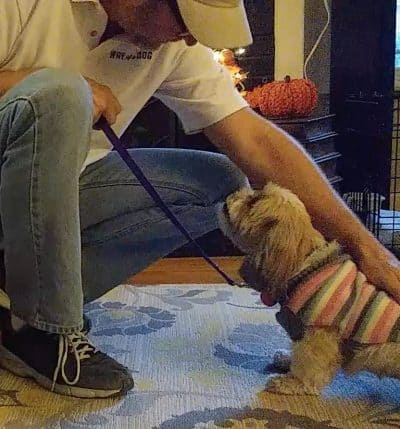
That’s why when all of our commands are simultaneous to each other, so that however, whichever one gets them to go, then they will go.
No. No. Sit down. Sit. Sit. Sit. Sit. Sit. Sit down. There you go. No. Sit down. Good stuff.
Now, I don’t know if you can see, but she still wants to come-
Speaker 1: This way.
Speaker 2: That way.
Hold on. Hey. Hey. Stop. There you go. Sit. No. Come here. Come here. Come on. Right there. Sit. Good. Well, hey. Sit. There you go. Hey. Stop.
So she’s lookin’ around, and then when she looks up at me like, “What?” Then I give her the command. She’s looking around right now. She’s looking around. She’s not seeing me. There. Okay. Good. You’re teaching her that positive reinforcement gets results in her listening to you.
Right now, it’s subtle. She’s kind of a little overwhelmed by what’s going on here.
But the fact that she’s picking it up, that means that she has the capacity to learn and listen, but it’s getting her to learn and listen is the trick. All right? Sit. Sit. Sit. Sit.She hears you, but she can’t see you. So that’s freaking her out. Stop.
So now, because she’s not right there, she’s more like this now. She’s more nervous because, one, she doesn’t have a straight sight. She can only hear you, so she might be drawn, like she’s like, “Mom’s out there. She’s lost without me,” or vice-versa. “I’m lost without her.”
Good. No. Come here. Sit. Sit. Sit. Sit. There you go. Good girl. Good girl. Stop. Hey. Hey, hey, hey, hey, hey. Look at me. Look. Look. Look. Hey. Hey. Stop.
Speaker 1: She has a stubborn streak.
Speaker 2: Yeah, she doesn’t want to look.
Hold on. Good. Good. Good girl. Just stop. Good girl. Thank you. Very good. So she doesn’t know … No. Good. There you go.
She doesn’t know yet why she’s getting little good job’s, but that is gonna start seeding. It’s gonna start, “Oh, well, I like it. Oh, I want to be mean. But, oh, I like that.”
So she’s going from here to here in the scale. She’s been leader, and now we kinda want her to come down, drop her position in your world as a listener and not as a leader. So the transition is where she may be stuck between two worlds, to listening to you, and to listening to her and her, ’cause she’s listened to her and her for so long, she’s used to it. That’s how it is.
But you have to go, “No, not anymore. This is the new way, and it’s a great way. It’s a wonderful way. We love you. We give you these things that you want, which is the pets and the love, and the oh, good dog, but only when she is being the dog that we want her to be.” She’s gonna find that when you’re happy, she’s gonna be happy, and the way to make you happy is for her to listen to you and not her. Ready? Walk. I see. that’s the essence of positive reinforcement.
Stop. Good. Sit. Hey. Hey. Hey. Sit. Sit. Sit. Sit down. There you go. Stop. Hey. Good. Thank you. Right there.
She saw you briefly. Right? But she doesn’t get to go. We’re building her ability to not be so needy for you. That’s what we’re doing. We’re just basically helping her, and you’re going to help her.
Walk. Walk. There you go. Right here. Walk, walk, walk. There you go. Good. Walk, walk, walk. There you go. Right there. There you go. Stop. Sit. Sit. Look at how I’m gonna have her sit.
Speaker 1: Facing you.
Speaker 2: Yes. There you go. Thank you. Because I had to. I can’t be a willing party for her to ignore me, like turning around. “Are you there? Are you still there? I’m freaking out. I need to know that you’re still there so I can see you, and I’m gonna bend and twist and show you how much …”
Sit down. Sit down. Sit. Sit. Sit. Sit. Sit. Sit down. Sit down. There you go. Good. Good girl. Thank you, dear. That’s a good girl.
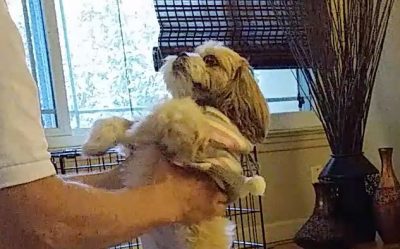
She doesn’t want to, but we’re transitioning her from a leader to a follower, and there will be a transition. There will be, “I don’t want to do that. I’m just not gonna do it.” But then eventually, because when she starts listening and just sitting, she doesn’t know why, but she’s getting some sugar, even in her, “I hate this. I’m not sitting here with some stranger.”
Hey. Are you okay down there? You okay down there? You okay? There you go. There. She wasn’t looking at me. So I wanted was, the moment her eyes, she’s like, “I don’t like you. I don’t like you,” and the way she goes like this, I remind her, but I give her nice little positive reinforcement love, nice little sweet treats. I call them treats. They’re sugar. This is the sugar. It’s not the food, it’s the reward.
Let me see you. Let me see you. No. No. No. Boy, she shows those teeth. That’s pretty scary. Let me see.
Speaker 1: I know.
Speaker 2: There you go. All right. Let me see you. Now, you see that she’s staying there with her feet? Look at her feet.
Speaker 1: Yeah.
Speaker 2: Earlier, she was curling up, and because … I call it lobster belly when they hold tight. They curl up in a ball from the belly up. But what this does is by just lifting them up, gravity kind of helps pull ’em right back down. So it’s just a way for them to be like this, and then they’re stretched out like, “Oh, it feels good. But I want to do this again. Then I’ll stretch it.”
Hold on. No growling. No. No. Stop. Shh. Stop. Good. No. No. No. Shh. No.
Speaker 1: That face.
Speaker 2: It is. It’s kind of terrifying.
Speaker 1: I know.
Speaker 2: Hold on. Shh.
So I’m gonna work the back of her neck muscles right now because they’re really tense.
Hold on. Shh. Hey. Good. Relax. Relax. Relax. Relax. Shh. There you go. There you go. So I’m putting her in a position that’s not really comfortable. It’s different. It’s not normal. She doesn’t like being lifted and jostled. But that’s what has to be done.
She’s like, “Don’t touch me. Don’t touch me,” and we want to touch ’cause we gotta desensitize her. She’s like, “Oh, just leave me alone, and I’ll be fine.” But no, you need hugs. You need lots of hugs. We’re gonna hug you, like when someone is mad at you, and you just want to hug ’em. “No, don’t hug me. I hate you. I hate you.” Then you hug ’em long enough, and they go, “I love you. I love you.” You know what I mean?
Speaker 1: Yeah.
Speaker 2: There’s that certain point where …There you go. Relax. Relax. There. But you can’t let her go back and feel like she’s ruling the roost again. She’s gotta be at the bottom of the rung. But at the bottom of the rung, that’s where all the good stuff is. That’s where everything lands. That’s where all the love and the attention and the pets and all this stuff …There you go.
Just wanna get that big muscle right there.
Oh, that’s a good doggie, right there. I got the sniffles. Let me see. Let me see you. There you go. Relax. Relax. Just relax. Relax. Shh. Relax. Relax. Shh. You okay? You okay?
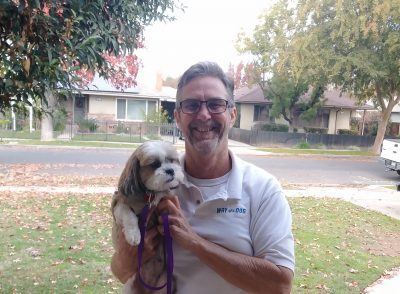
…end of transcription!


